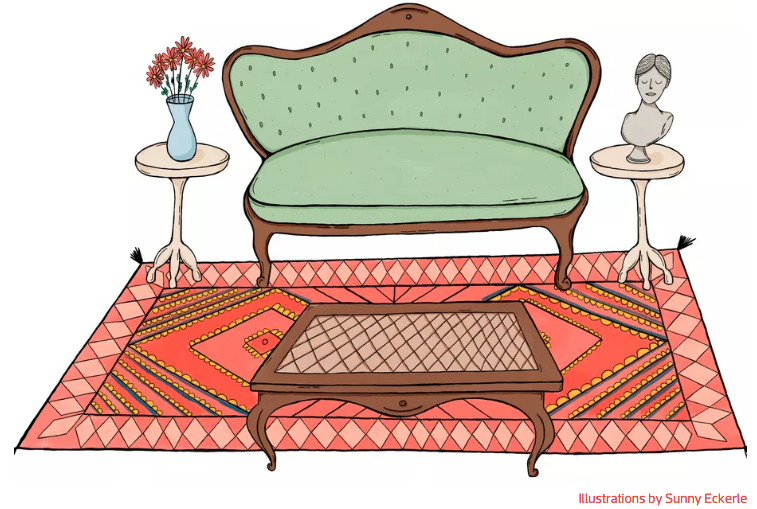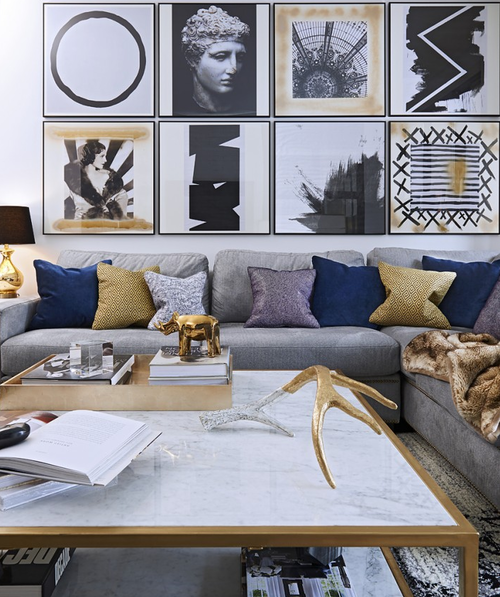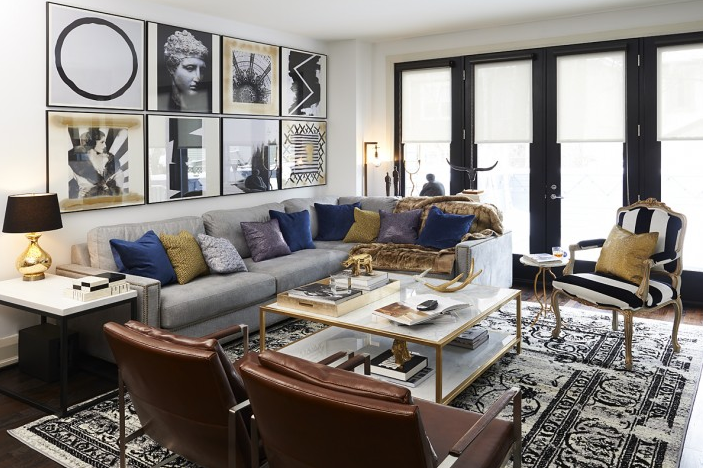|
From China to America and Back Again!
We are happy (and sad) to announce that our talented Project Designer, Jessica Liu, has left our San Diego office to join our Shanghai team! Jessica started her career with Andesign, Inc. in La Jolla, CA during the fall of 2015. After one year as a Design Assistant, she has been promoted to a Project Designer role and grown to be an integral member of our international company. Back in Shanghai, she will wed her high school sweetheart and continue to contribute her creative multi-tasking, bilingual talents to both continents. If one thing is for sure... there will be much fighting over her time between our domestic and international offices! We miss her already and wish her all the best! BY MELISSA DALTON Alison Davin’s San Francisco-based firm, Jute Interiors, specializes in crafting home interiors from start-to-finish, from space planning to final furniture selection. She gave us her top tips for getting the furniture to fit just right. 1. Ergonomics are fundamental "We always start with function," says Davin. "Having something fit your ergonomic requirements trumps what it looks like in the space." This means Davin reviews all of the uses for a particular piece and makes sure to incorporate the client’s personal preferences. For instance, she might place a higher-backed sofa before the television so that tall family members don’t have to lie down every time they watch a show. In the dining room, Davin often hears the request for "three hour chairs," meaning seats need to be comfortable for long meals. Lastly, she says to check with the whole family before making a final purchase. "Weigh in with all the different family members and get their ergonomic requests," she says. Everybody sits in the sofa differently, so having everyone try it out first is important to avoid costly returns. 2. Double-check dimensions Catalog photos are deceiving, says Davin, and never depict the size and scale of items accurately. "Definitely look at the dimensions before you order something that you haven’t seen [in person]," she says. Ask yourself how a piece will fit in the intended room, as well as how it will be transported there. The latter is too often overlooked. Davin has heard many stories from clients about furniture-buying attempts that ended up with their purchase never actually making it in the house. "It didn’t fit in their freight elevator or through their front door," she says. Before buying, use painter’s tape to block out where the piece will go in the room and take measurements of all the doors and stairwells it will traverse to make it home. 3. Consider construction Davin suggests doing a bit of research into where a piece of furniture was made and its materials, in order to avoid products that might contain harmful chemicals such as formaldehyde or fire retardants. Both substances have historically been common in furniture construction. Formaldehyde is currently found in wood glue, while fire retardants are often in upholstery foam. While it’s not possible to completely avoid contact with these chemicals, making more informed purchases might lessen your exposure via their off gassing.
To do so, Davin endorses US-made products over imports, and buying solid wood over composite wood construction. "Many US retailers are sensitive to using hardwood versus composite wood that’s glued together with formaldehyde," she says. "In the states there’s a lot more hardwood being used and it’s not only a better product, it’s going to last longer and it doesn’t off gas." Here’s a roundup from the Environmental Working Group of five couches without fire retardants that can be bought from large retailers, including Ikea, Room & Board, and Crate and Barrel. 4. Don’t be afraid to go bigger Assessing whether a piece of furniture is proportional to the room and to the other pieces around it, or understanding if you got the scale right, can be tricky for non-designers. "If somebody can’t necessarily figure it out, I think it’s always good to not be afraid of larger pieces," says Davin. She says that clients often assume that a tall armoire or a large sectional will make a space feel cramped, but she finds the reverse to be true. "If positioned correctly, larger pieces can often make a room feel bigger," she says. "Putting a lot of small pieces in a small room just makes the room feel smaller." 5. Balance shapes To get a pleasing mix of furniture pieces in a single room, Davin suggests varying their basic shapes. "What I typically do is count up how many rectangles, diamonds, and circles are in a space," she says. Then she makes sure one shape isn’t overly dominant in the scheme. "For instance, if you have a round lampshade and a round mirror above a fireplace, then maybe you do a rectangular coffee table and a rug that has a graphic pattern, just to balance out the shapes," says Davin. 6. Try vintage or custom Davin always prefers scouting out vintage furniture or having something custom built for a space, rather than buying from big box retailers. "Usually we will start with vintage stuff and then build [the room] around them," she says. "You’ll probably be able to go to a retailer and fill in the blanks with the leftover dimensions." When shopping for vintage, she has just one suggestion: "Find things that you absolutely love." If having custom goods built to your specifications seems too intimidating, Davin proposes purchasing a custom rug. "If somebody’s going to shop at a chain store and buy everything there, I would recommend that they then go to a carpet retailer where they might buy wall-to-wall carpet," she says. "Give them the dimensions and have them take one of their rugs and bind it to the perfect size, because having a rug that is custom to the space can elevate the room more than anything else." Read the original article on curbed.com. EMPLOYEE SPOTLIGHT: EMILY TABER-MOORE, SENIOR DESIGNER
Working as a team from overseas, our La Jolla and Shanghai offices created a stunning design proposal for a high-end law firm in Taiyuan, China. Stateside, our Senior Designer created a concept design for the law office and then worked closely with our Shanghai office to have realistic renderings produced. The design was based on catering to a high-end clientele -- showcasing luxury features with a diamond-etched glass wall and contemporary marble flooring. Warm wood tones and soft carpeting were implemented throughout the space to balance the modern details.INSPIRATIONRECEPTIONVIP LOUNGEOPEN WORKSPACECONFERENCE ROOMWith so many new services for interior decorating and design help, I've heard a LOT of discussion about the question whether or not to hire an interior designer. How do you know which avenue is best? Where is the best place to hire them from and how do you know if you are making the right decision? All very valid questions. I'll do my best today to try and answer these, but one thing I know for sure... the old saying "you get what you pay for". I've seen so many home tours on some pretty major style websites and I just think to myself, everybody's home looks the same. With just a few personal twists, most of the house tours I see are just a repetitive version of the ones last month. I've noticed that even my own clients, send me things that they found on Instagram in someone else's home and they want this or that. Drives me crazy. When I see a space that I love, I know its done by a designer, or someone who is professionally trained in the field. It's a standout space that actually looks like the pages of a magazine and here's why. . . 1. It's formally functional. You can always tell a home was planned out by a professional because of the spacing and layout. Take this living room for example. The spacing and placement of the furnishings, artwork, lighting, etc. It's symmetrical, the legs are all the furniture mimic each other, the coffee table is the right height and size, the rug is actually the right fit for the space, the art on the left mimics the windows/doors on the right. When it comes to form and function, a designer always does things harmoniously. 2. The mix makes sense. Mixing metallics, furniture styles, colors, etc. I once had a client, who hired one of the "designers" who was a sales person at a large retail store. She claimed to be an experienced designer and he told her he wanted something unique and cool for his formal dining room. For months, something about it didn't feel right to him but it looked like a nice dining room. He hired me for a second opinion and when I walked in I gasped with fear. In this dining room was a cement table (that was actually meant for outdoors), plastic chairs (also meant for outdoor dining), a rug that was also plastic and a light fixture that clearly was meant for a kitchen bar. While the look was cool and the style of the each piece was hip and trendy, the furniture made ZERO sense in the space. Why would anyone want to dine in outdoor plastic chairs on a hard cement table when the home was meant to be cozy and comfortable? This may "look cool" in a showroom, but makes absolutely no sense in a home. (By the way, this guy spent a LOT of money on those items and had an enormous, beautiful home and thought he was hiring a designer...which leads me to my next point) 3. A professional assessment. When you are shopping for a designer/decorator to work on your home, you want to make sure you are getting the right information. Pay for a proper consultation. Don't skimp out and try to get decor advice for free. That's what blogs and Pinterest are for. You want someone to help with the overall layout, look and feel of your home, you want it to make sense. You're not going to get proper advice by just asking for tips here and there. I have seen so many homes that have a very mismatched vibe. Your home is your sanctuary and you want it to nurture your lifestyle and family, not drain you. A professional will be able to come in and let you know what's working and what isn't, when the lighting is off, when the placement isn't functional, etc. 4. You will save money! If you pay for a designer, here are a few things you might miss out on. Accidentally paying too much for something, when you can get the same thing for half the cost at another place, ordering the wrong size, fabric or wallpaper, wasting money on a random electrician who drops & breaks your chandelier (yes this happened to my friend!), choosing wall colors that don't give the feel you want, buying furniture that doesn't fit in the space, I could go on and on. Typically designers have experienced most of the mistakes for you and know ahead of time, the right way to go. You want experienced people working on your home so you can save money from making the wrong mistakes. Trust me, they happen! I have been the designer to come in and clean up the mess of somebody else's mistakes and they can be pretty costly. 5. The bad guy. Let's face it, when you are renovating or working on a home (especially your first time), you want someone who will ask the right questions and fight for you. Contractors, electricians, inspectors and the like can be pretty intimidating. It's really nice to have a middle man (your designer) who can ask questions for you, get things done for you and generally be the "bad guy" and stand up on your behalf. Many of my clients are so nice and hate to ask for more than what they are given. A designer will do that for you. I once had a wallpaper installer tell my client "this or that can't be done", then I came in, asked the right questions and it was done. 6. Unique ideas. A designer is going to come up with things you wouldn't normally think of. Like this picture above. How many people would turn an empty nook like this into a chic little vanity? It was a clever move and not something you would normally think of. Designers will be able to come up with unique solutions for your home and again, with the ability to avoid costly mistakes. The more unique the space, the cooler it is, this is why you want a designer who gets your personality. Tip: Don't just hire any designer! Have a meeting or lunch, see how you get along with that person. They need to "get you".
7. Increase your value. A good designer will have the ability to turn your home into a space ready for a magazine or showcase. Here's the thing, there is a big difference when it comes to decorating a home stylishly and one that is decorated properly for photography. If you know you are going to sell your home in a few years, you want it designed for resale at some point. You are going to need stellar photos to help sell your home and there are specific ways to enhance your home for photography. These things designers know. If this is the case, try asking a real estate agent for the name of a designer in your area, they typically will have fantastic & dependable resources. 8. Get more sleep. Check off all those things that you don't get around to doing in the home off of your list. A designer/decorator will be the person who will get things done like frame that art that's been sitting there forever, make sure that leak gets fixed, know the right person to install or fix that light, stock up your home where guests will be delighted with what you have, and ultimately probably have your bed so well done and comfortable you'll sleep better than if you had thrown it together yourself. Read the original article on TheDecorista.com.
Are you following us on Pinterest? Follow along to see our latest inspirations, favorite product finds and new project boards! www.pinterest.com/andesigninc
Does your design style reflect YOU? Or are you a multiple design personality? We paired some minimalist, avant-garde shoe designs with interiors that might be a reflection of their designer's lifestyle standards (similar analogy to why dogs look like their owners). Minimalism will always take the cake with a subtle, yet unforgettable statement. The key ingredients are: timelessness, functionality and simplicity. 'Less is more' certainly speaks volumes.
Short history lesson: "Minimalism emerged in New York in the early 1960s among artists who were self-consciously renouncing recent art they thought had become stale and academic. A wave of new influences and rediscovered styles led younger artists to question conventional boundaries between various media. The new art favored the cool over the 'dramatic.'" - TheArtStory.org.
Proper staging can help you sell your home faster, and possibly even for a higher price, and in recent years stagers have become even savvier at zeroing in on what buyers want. I spoke with three home staging professionals to find out what works these days, from the tried and true basics to fresh ideas for prepping a home for a quick and profitable sale. Whether you are planning to hire a pro or want to learn a few tricks to do it yourself, these tips will get you up to speed on the latest techniques in staging to sell. 1. Find the right pros to work with. "I feel the most important thing for homeowners to focus on is choosing a great Realtor to represent them and to properly showcase their property with professional photos and staging suggestions," says home stager Kelley Gardner in Madison, New Jersey. "I see too many poor photos, no floor plans and no staging. Most buyers are making their final selections using the tools of the Internet, so they will rule out the dated, ugly, messy homes that could actually be a gem if the homeowner had just taken the time to update the rooms with very little effort."
If you are finding it difficult to let go of personal items, hiring a staging pro can help, say Robin DeCapua and Rachel Moore of Madison Modern Home in Los Angeles: "They can look at your home with fresh eyes and see both the strengths and flaws that may be invisible to you as a homeowner." 2. Detach yourself from your house. The process of staging takes the focus of your home away from you and puts it on the potential new owners of your home. Shirin Sarikhani of Seattle Staged To Sell likes to show sellers photos of staged versus unstaged rooms to show what a striking difference staging makes. "I also help them understand that empty rooms look smaller than staged rooms," she says. "I try to let the home sellers understand that home staging is an investment and not a cost. The first step a home seller can take to ensure a successful outcome is to get detached from their home; now it is all about the buyers." 3. Focus on the front.Wondering where to begin? Try sprucing up your home's curb appeal."Buyers make up their mind in the first 30 seconds as they approach the front door," says Gardner. "Clean it up, paint and update the old weathered light fixture. Trim foliage, take out dead plantings and mulch if you are in a growing season. When your home hits the MLS, light it up. Potential buyers tend to drive by before they actually get inside." 4. Say goodbye to ugly. There is really no nice way to say it: We all have a few ugly bits in our homes, and it's best to face the facts early on. The good news: There are plenty of quick fixes for your home's trouble spots. "White towels and a white waffle-weave shower curtain can do wonders to a dated bath," says Gardner. "If you have oak kitchen cabinets, paint them white and add quartz or stone counters to help update. Remove dated wallpaper and paint. Take down dusty, dated window treatments. Inexpensive updates can include changing out light fixtures, throw pillows and bed linens. I like a white quilt or duvet for photos." 5. Know your buyer. This is the golden rule of staging. The new paradigm is a targeted approach capturing the likely buyer pool through specific design styles that will resonate, such as hipster, industrial or beachy modern style, say DeCapua and Moore. Gardner adds that buyers in their mid-20s to mid-30s make up a large part of the market, so "that is the group to capture and market toward," she says. "They usually like the look of the big-box stores, like Crate & Barrel, Restoration Hardware and Pottery Barn, so I like to show the homeowners these catalogs to get the feel of this transitional style." If you are staging your home yourself, ask your real estate agent for help identifying your target market. Read the original article on Houzz.com. |
why, helloWelcome to the inner workings of our minds! Here you will find random musings ranging from creative exploits, everyday adventures, our current must-haves and everything in between. We hope you enjoy, and thanks for stopping by! Categories
All
Get SocialArchives
August 2017
|
Copyright © 2018 AND Design & Development, Inc. All Rights Reserved.







































 RSS Feed
RSS Feed